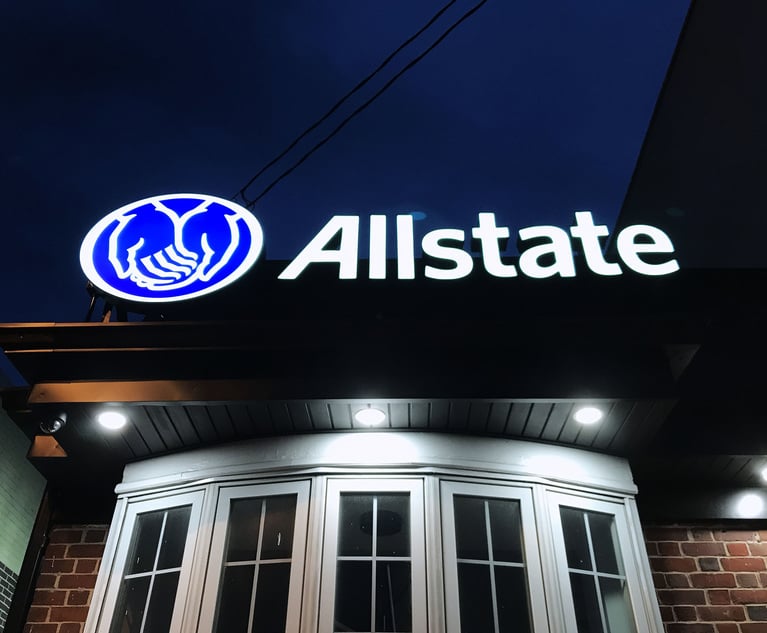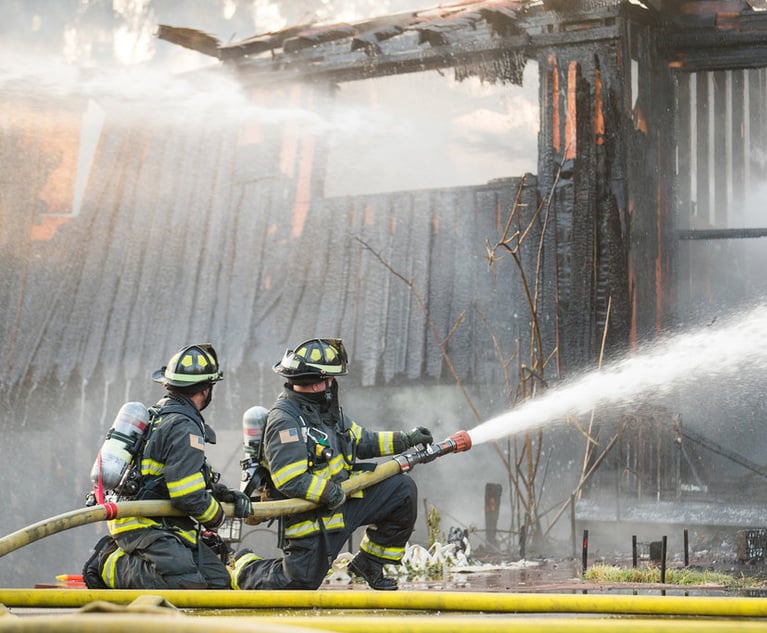Are They Clients? Lawyers Should Pay Attention to Kubicki Draper's Malpractice Defense
The case asks whether an insurance company can be considered a client of the law firm it hired to represent a customer.
March 04, 2020 at 07:10 PM
5 minute read
 Florida Supreme Court arguments: Edward Guedes of Weiss Serota Helfman Cole & Bierman in Coral Gables, left, and Christopher Carlyle of the Carlyle Appellate Law Firm in Orlando.
Florida Supreme Court arguments: Edward Guedes of Weiss Serota Helfman Cole & Bierman in Coral Gables, left, and Christopher Carlyle of the Carlyle Appellate Law Firm in Orlando.
The Florida Supreme Court will decide on the future of a legal malpractice lawsuit against Florida law firm Kubicki Draper, after attorneys on either side disputed whether the plaintiff has standing to sue.
It's a case that asks what duties lawyers have to third parties after alleged malpractice, by questioning whether an insurance company is legally a client of the law firm it hired to represent a customer.
Arch Insurance Co. brought the legal malpractice lawsuit against Kubicki Draper in 2008 over the law firm's defense of a customer—South Florida accounting company Spear Safer CPAs and Advisors—against a multimillion-dollar accounting malpractice lawsuit.
That case resulted in a $3.5 million settlement—within a $5 million policy limit. But Arch Insurance claimed that amount would have been a lot lower if Kubicki Draper attorneys had used a statute-of-limitations defense earlier in the litigation.
Oral arguments before Florida's high court Wednesday followed a finding from the Fourth District Court of Appeal that Arch did not have legal standing. The lower court found the Arch couldn't sue, because the insurance company was never really the law firm's client.
Related story: Kubicki Draper Beats Insurance Company's Malpractice Suit
The appellate ruling flagged the question of standing as one of great public importance.
But the insurer's attorney, Edward Guedes of Weiss Serota Helfman Cole & Bierman in Miami, asked the court to reverse that.
Guedes argued there was a contractual relationship between the insurance company and Kubicki Draper, and therefore an understanding that they were also representing Arch's interests, making the insurer "a co-client."
"The insurer should have the same access to the courts to remedy its injury as any other client," Guedes said.
Guedes highlighted that an intake form for the firm referred to Arch Insurance as the "carrier client." He pointed to documents that he said showed lawyers providing advice only to the insurer, leaving the insured out of the equation, including one occasion where an attorney advised Arch Insurance on its exposure to a potential bad-faith claim. The insured wasn't copied on that correspondence, according to Guedes.
"What we have here at every instance, on every occasion in the interaction of these parties, is that everyone understood that retained counsel was representing the interests of both entities," Guedes said.
Duty?
The case could result in a statewide rule change, creating a duty for law firms toward nonclients in certain circumstances, if the justices side with Arch Insurance.
Chief Justice Charles Canady pressed Kubicki Draper's lawyer Christopher Carlyle on whether the insurer had legally contracted with the law firm.
"The reality here is if the insurer had stiffed the law firm on the fees, there would have been a suit based on a contractual relationship with the insurer," Canady said.
But Carlyle argued that whatever connection there was didn't rise to a dual client relationship and didn't mean their legal interests were aligned. Instead, as Florida law currently dictates, Carlyle said the parties themselves should be left to define what their relationship is.
"If you create this situation where they [lawyers] are adequately representing the rights of the insured and this case settles within policy limits, what goes through the lawyers' minds during those negotiations, during the course of that lawsuit? Knowing that, 'Perhaps I'll be second-guessed later on down the road by the insurance company if you create this ability to do so,'" Carlyle said.
He argued that to side with the insurer would be to "ignore all the nuances, ignore the fact that the parties can control their relationship and allow a malpractice suit without any distinctions, despite the fact they've made some distinctions today."
The insurer's policy did include a subrogation clause, meaning one party could have the right to step into another's shoes in certain scenarios. When Justice Ricky Polston asked why the insurer shouldn't be able to use the clause in this instance, Carlyle said the company couldn't show harm. The attorney argued the insurer's customer had received the benefit of its bargain with Arch, which had in turn seen the claim settle within policy limits.
"What harm am I subrogating?" Carlyle asked. "How is that harm being transferred to the insurance company? … What harm has it suffered?"
The high court has yet to rule.
Read more:
Is This South Florida Traffic Ticket Company Practicing Law Without a License?
Federal Lawsuit Claims South Florida Firm's Negligence Caused Company's $4M Loss
This content has been archived. It is available through our partners, LexisNexis® and Bloomberg Law.
To view this content, please continue to their sites.
Not a Lexis Subscriber?
Subscribe Now
Not a Bloomberg Law Subscriber?
Subscribe Now
NOT FOR REPRINT
© 2025 ALM Global, LLC, All Rights Reserved. Request academic re-use from www.copyright.com. All other uses, submit a request to [email protected]. For more information visit Asset & Logo Licensing.
You Might Like
View All

Once the LA Fires Are Extinguished, Expect the Litigation to Unfold for Years
5 minute read
Attorneys, Health Care Officials Face Nearly $80M RICO Suit Over Allegedly Fabricated Spreadsheet

Navigating Florida Property Insurance Claims in a Post-Fee-Shifting World
5 minute readLaw Firms Mentioned
Trending Stories
- 1Decision of the Day: Trial Court's Sidestep of 'Batson' Deprived Defendant of Challenge to Jury Discrimination
- 2Is Your Law Firm Growing Fast Enough? Scale, Consolidation and Competition
- 3Child Custody: The Dangers of 'Rules of Thumb'
- 4The Spectacle of Rudy Giuliani Returns to the SDNY
- 5Orrick Hires Longtime Weil Partner as New Head of Antitrust Litigation
Who Got The Work
J. Brugh Lower of Gibbons has entered an appearance for industrial equipment supplier Devco Corporation in a pending trademark infringement lawsuit. The suit, accusing the defendant of selling knock-off Graco products, was filed Dec. 18 in New Jersey District Court by Rivkin Radler on behalf of Graco Inc. and Graco Minnesota. The case, assigned to U.S. District Judge Zahid N. Quraishi, is 3:24-cv-11294, Graco Inc. et al v. Devco Corporation.
Who Got The Work
Rebecca Maller-Stein and Kent A. Yalowitz of Arnold & Porter Kaye Scholer have entered their appearances for Hanaco Venture Capital and its executives, Lior Prosor and David Frankel, in a pending securities lawsuit. The action, filed on Dec. 24 in New York Southern District Court by Zell, Aron & Co. on behalf of Goldeneye Advisors, accuses the defendants of negligently and fraudulently managing the plaintiff's $1 million investment. The case, assigned to U.S. District Judge Vernon S. Broderick, is 1:24-cv-09918, Goldeneye Advisors, LLC v. Hanaco Venture Capital, Ltd. et al.
Who Got The Work
Attorneys from A&O Shearman has stepped in as defense counsel for Toronto-Dominion Bank and other defendants in a pending securities class action. The suit, filed Dec. 11 in New York Southern District Court by Bleichmar Fonti & Auld, accuses the defendants of concealing the bank's 'pervasive' deficiencies in regards to its compliance with the Bank Secrecy Act and the quality of its anti-money laundering controls. The case, assigned to U.S. District Judge Arun Subramanian, is 1:24-cv-09445, Gonzalez v. The Toronto-Dominion Bank et al.
Who Got The Work
Crown Castle International, a Pennsylvania company providing shared communications infrastructure, has turned to Luke D. Wolf of Gordon Rees Scully Mansukhani to fend off a pending breach-of-contract lawsuit. The court action, filed Nov. 25 in Michigan Eastern District Court by Hooper Hathaway PC on behalf of The Town Residences LLC, accuses Crown Castle of failing to transfer approximately $30,000 in utility payments from T-Mobile in breach of a roof-top lease and assignment agreement. The case, assigned to U.S. District Judge Susan K. Declercq, is 2:24-cv-13131, The Town Residences LLC v. T-Mobile US, Inc. et al.
Who Got The Work
Wilfred P. Coronato and Daniel M. Schwartz of McCarter & English have stepped in as defense counsel to Electrolux Home Products Inc. in a pending product liability lawsuit. The court action, filed Nov. 26 in New York Eastern District Court by Poulos Lopiccolo PC and Nagel Rice LLP on behalf of David Stern, alleges that the defendant's refrigerators’ drawers and shelving repeatedly break and fall apart within months after purchase. The case, assigned to U.S. District Judge Joan M. Azrack, is 2:24-cv-08204, Stern v. Electrolux Home Products, Inc.
Featured Firms
Law Offices of Gary Martin Hays & Associates, P.C.
(470) 294-1674
Law Offices of Mark E. Salomone
(857) 444-6468
Smith & Hassler
(713) 739-1250






